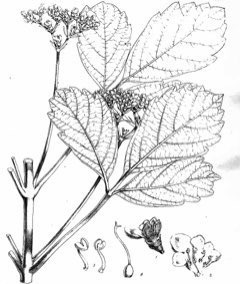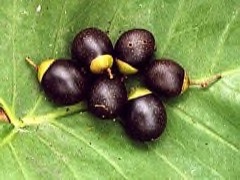 |
|
http://www.edibleplants.org |
 |
| Scamperdale flickr |
Translate this page:
Summary
Found in tropical Africa, Vitex madiensis is a shrub or small tree about 5 m tall with a massive underground woody rootstock. The fruits, oblong to round and purple-black, are edible with a sweet flavor. The leaves and roots have medicinal uses but no further details are mentioned in the report. Bark extracts are used in the treatment of skin diseases and toothache. Essential oil from the leaves has a sweet and penetrating fragrance. The branches are used as chew sticks for teeth and gums. The wood is used for fuel and to make charcoal.
Physical Characteristics

 Vitex madiensis is a TREE growing to 4 m (13ft) by 4 m (13ft) at a medium rate.
Vitex madiensis is a TREE growing to 4 m (13ft) by 4 m (13ft) at a medium rate.
See above for USDA hardiness. It is hardy to UK zone 10. The flowers are pollinated by Bees.
Suitable for: light (sandy), medium (loamy) and heavy (clay) soils and prefers well-drained soil. Suitable pH: mildly acid and neutral soils. It cannot grow in the shade. It prefers moist soil.
UK Hardiness Map
US Hardiness Map
Synonyms
Vitex bakeri B.L.Rob. Vitex barbata Planch. ex Baker Vitex camporum B?ttner Vitex cordata Aubr?v. Vi
Plant Habitats
Edible Uses
Edible Parts: Fruit Oil
Edible Uses: Oil
Fruit - raw or cooked[323 ]. Sweet and mealy[398 ]. The thin pulp clings to the stone, which contains 3 to 4 seeds[323 ]. The purple-black fruit is about the size of an olive[323 ]. The oblong-rounded fruit is about 25mm long and 10 - 20mm wide[398 ].
References More on Edible Uses
Medicinal Uses
Plants For A Future can not take any responsibility for any adverse effects from the use of plants. Always seek advice from a professional before using a plant medicinally.
Odontalgic Skin
The leaves and roots have medicinal uses[323 ]. Bark extracts are used in the treatment of skin diseases and toothache[774 ].
References More on Medicinal Uses
The Bookshop: Edible Plant Books
Our Latest books on Perennial Plants For Food Forests and Permaculture Gardens in paperback or digital formats.

Edible Tropical Plants
Food Forest Plants for Hotter Conditions: 250+ Plants For Tropical Food Forests & Permaculture Gardens.
More

Edible Temperate Plants
Plants for Your Food Forest: 500 Plants for Temperate Food Forests & Permaculture Gardens.
More

More Books
PFAF have eight books available in paperback and digital formats. Browse the shop for more information.
Shop Now
Other Uses
Charcoal Cosmetic Fuel Oil
Other Uses The leaves yield an essential oil of such sweet and penetrating fragrance that it has been recommended for commercial development[323 ]. The branches are used as chew sticks for maintaining the health of teeth and gums[774 ]. The wood is used for fuel and to make charcoal[398 ].
Special Uses
Food Forest
References More on Other Uses
Cultivation details
References Carbon Farming Information and Carbon Sequestration Information
Temperature Converter
Type a value in the Celsius field to convert the value to Fahrenheit:
Fahrenheit:
The PFAF Bookshop
Plants For A Future have a number of books available in paperback and digital form. Book titles include Edible Plants, Edible Perennials, Edible Trees,Edible Shrubs, Woodland Gardening, and Temperate Food Forest Plants. Our new book is Food Forest Plants For Hotter Conditions (Tropical and Sub-Tropical).
Shop Now
Plant Propagation
Seed -
Other Names
If available other names are mentioned here
ekarukei, murukukwe, odoandri, oyelo gwok.
Native Range
AFRICA: Angola, Benin, Burkina, Burundi, Cabinda, Cameroon, Central African Repu, Chad, Congo, Gabon, Gambia, Ghana, Guinea, Guinea-Bissau, Ivory Coast, Kenya, Malawi, Mali, Mozambique, Niger, Nigeria, Senegal, Sierra Leone, Somalia, Sudan, Tanzania, Togo, Uganda, Zambia, Zaïre, Zimbabwe.
Weed Potential
Right plant wrong place. We are currently updating this section.
Please note that a plant may be invasive in one area but may not in your area so it's worth checking.
Conservation Status
IUCN Red List of Threatened Plants Status : This taxon has not yet been assessed

Growth: S = slow M = medium F = fast. Soil: L = light (sandy) M = medium H = heavy (clay). pH: A = acid N = neutral B = basic (alkaline). Shade: F = full shade S = semi-shade N = no shade. Moisture: D = dry M = Moist We = wet Wa = water.
Now available:
Food Forest Plants for Mediterranean Conditions
350+ Perennial Plants For Mediterranean and Drier Food Forests and Permaculture Gardens.
[Paperback and eBook]
This is the third in Plants For A Future's series of plant guides for food forests tailored to
specific climate zones. Following volumes on temperate and tropical ecosystems, this book focuses
on species suited to Mediterranean conditions—regions with hot, dry summers and cool, wet winters,
often facing the added challenge of climate change.
Read More
Expert comment
Author
Oliv.
Botanical References
Links / References
For a list of references used on this page please go here
A special thanks to Ken Fern for some of the information used on this page.
Readers comment
| Add a comment |
|
If you have important information about this plant that may help other users please add a comment or link below. Only comments or links that are felt to be directly relevant to a plant will be included. If you think a comment/link or information contained on this page is inaccurate or misleading we would welcome your feedback at [email protected]. If you have questions about a plant please use the Forum on this website as we do not have the resources to answer questions ourselves.
* Please note: the comments by website users are not necessarily those held by PFAF and may give misleading or inaccurate information.
To leave a comment please Register or login here All comments need to be approved so will not appear immediately.
|
Subject : Vitex madiensis
|
|
|
|